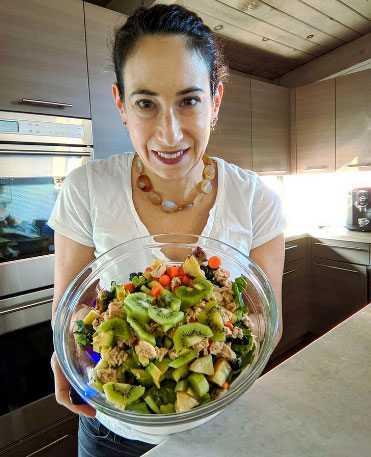Within the autoimmune community, exercise intolerance is a real struggle. We all know that movement is really important to reduce inflammation. However, exercise intolerance can prevent you from recovering from even the gentlest movements. If you feel completely wiped out after you exercise, or even experience severe reactions like vomiting, nausea, blurred vision, or even trouble to breathe you may be suffering from exercise intolerance. The good news is you can overcome exercise intolerance. Here’s an explanation of what causes it and what you can do to start moving your body again.
What Causes Exercise Intolerance?
Exercise intolerance is the inability to exercise or to raise your heart rate. It was first discovered in the cardiac community, but it’s becoming more common among autoimmune warriors. Those who suffer from exercise intolerance may feel extreme fatigue for days after working out. Additionally, it can cause extreme reactions such as vomiting, blurred vision, nausea, severe and or unusual muscle pain, flu-like symptoms, and autoimmune flares. These reactions can happen with only prolonged intense exercise, or they can kick in after doing the simplest of movements such as yoga or walking.
Mitochondrial Dysfunction
Mitochondrial dysfunction is actually what triggers exercise intolerance. If you remember cell structures from your high school grade biology class, the mitochondria are the powerhouse organelle of your cell. It’s where all of your energy for your body or your ATP is produced, and you get that energy from food. If your mitochondria aren’t working properly, the food you are eating isn’t being converted to energy as efficiently as it should. When this happens, it literally depletes your body of stored energy, and additional movement outside of what is required to survive becomes an additional burden for your body to handle so it literally shuts down as its survival mechanism.
Oxidative Stress
The other issue with exercise and taught with exercise is that it increases oxidative stress in the body. The mitochondria are actually the major producer of reactive oxygen species. Part of the issue with autoimmune diseases is that there’s an increase in oxidative stress. Adding exercise on top of the stress that our bodies are already experiencing can sometimes be too much. We all know that when the body lacks antioxidants, those free radicals generated by oxidative stress can cause damage to tissues and cells. In addition, the mitochondria are also partly responsible for regulating inflammation and the innate immune system.
The overproduction of reactive oxygen species triggers specific inflammasomes connected to the innate immune system. These inflammasomes can trigger an inflammatory reaction in the body. If you have chronic inflammation, which is generally the case with many autoimmune diseases, it is likely that the mitochondria are not functioning properly. When the mitochondria are not functioning properly, they’re likely not producing enough energy for your body to work which leaves you feeling tired and fatigued.
How to heal from exercise intolerance
Healing exercise intolerance takes patience. If you are working out and feeling totally drained that day or even for days afterwards, you are likely pushing it too hard. In addition, living with an autoimmune disease means that your immune system is constantly changing. You may feel great and energized one day, and wiped out the next. This is because there are so many external factors that can affect your immune system. So here are my tips for getting your body back to movement again:
Tip One: Listen to Your Body
Do not push it when the energy is not there. When you are feeling run down and exhausted, there’s clearly a reason. And that is not the time to suck it up and push through. One of the tricks I do to help me listen to my body is to avoid planning out my workouts in advance. That way I don’t feel guilty when I don’t fit a workout in. Instead, each morning I assess my energy levels and how my body feels, and base my workout on that. I even allow myself to sleep in if I’m feeling really drained. If your schedule allows it, try to keep openings throughout your day to fit a workout in. Sometimes when I feel like I need sleep, I’ll push my workout to the afternoon when I may feel more energized.
Tip Two: Ramp Up Exercise Slowly
As your body gets used to moving again, you can slowly start to ramp up the intensity. You just have to be very careful to not do too much too soon. If you start to feel sore, or exhausted, or experience any other negative symptoms, definitely take a few rest days and pull back. Remember, healing is never linear. Feeling great for one week or one month does not mean you are totally in the clear. Setbacks happen, so it is important to be very aware of your body and how you feel.
Tip Three: Focus on Key Nutrients to Help Your Mitochondria Recover
Here are a few nutrients you should start including into your eating pattern to help you overcome exercise intolerance.
Antioxidants
Given that the mitochondria are the major producers of ROS, it is important to have plenty of antioxidants in your diet to help capture those free radicals floating around in your body. Some of the best sources of antioxidants are found in colorful fruits and vegetables. Many of the foods in my anti-inflammatory guide are rich in antioxidants, so go download my free guide and check those out
B Vitamins
B vitamins play a major role in energy production and mitochondrial health. In fact, there is a connection between mitochondria and methylation. Methylation requires a number of B vitamins including folate, B12, B6, and thymine. The best sources of B vitamins are green leafy vegetables, animal protein, nuts, seeds, and organ meat.
Selenium
This mineral is another important player in reducing oxidative stress. Selenium can be found in Brazil nuts, chicken, eggs, and pork. In fact, eating two to three Brazil nuts daily will meet your minimum requirement for selenium.
Sufficient Protein
Protein is made up of amino acids and amino acids are needed to produce antioxidant enzymes. Diets low in protein can impact mitochondrial function. Protein can be found in both animal and plant-based sources like beans, grains, nuts, and seeds.
If you’re feeling wiped out or unable to exercise, you are not alone. exercise intolerance is very common in the autoimmune community. Remember, it’s a mitochondria issue. So the more you can work on reducing your inflammation and healing your body, the faster you will be able to return to exercise. Just start off slow, listen to your body and eat a variety of nutrient-dense foods to keep all of your body systems working properly.
If you need more help managing your diet and changing your lifestyle, please go to my contact page to schedule a free discovery call to learn more about my approach and for me to learn about your goals. In addition, you can also follow me on Instagram and Facebook.


